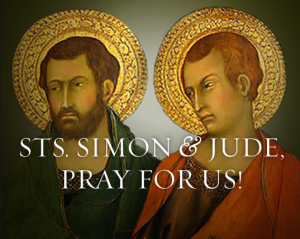Sts. Simon and Jude

യേശുവിന്റെ പന്ത്രണ്ട് ശിഷ്യന്മാരില് ഉള്പ്പെട്ടിരുന്ന ശിമയോ ന്റെയും യൂദാസ് തദേവൂസിന്റെയും ഓര്മദിവസമാണിന്ന്. ഇരുവരും ശിഷ്യന്മാരുടെ പട്ടികയിലെ അവസാന പേരുകാരാണെങ്കിലും വളരെ പ്രധാനപ്പെട്ടവര് തന്നെ. സുവിശേഷം പ്രസംഗിക്കവേ ഒന്നിച്ച് രക്തസാക്ഷിത്വം വരിച്ചു എന്ന വിശ്വാസമുള്ളതിനാലാണ് ഇരുവ രുടെയും ഓര്മദിവസം ഒന്നിച്ച് ആചരിക്കുന്നത്. ചെറിയ ശിമയോന് എന്നറിയപ്പെടുന്ന ശിമയോന്, ‘തീവ്രവാദിയായ ശിമയോന്’ എന്നാണ് വിളിക്കപ്പെടുന്നത്. പത്രോസ് ശ്ലീഹായുടെ പേരും ശിമയോന് എന്നായതിനാല് ഇരുവരെയും തിരിച്ചറിയുന്നതിനുവേണ്ടിയാവും ഈ വിശേഷങ്ങള് പേരിനൊപ്പം ചേര്ത്തുവിളിച്ചിരുന്നത്. വി. ഗ്രന്ഥത്തില് 13 ‘ശിമയോന്’മാരെപ്പറ്റി പരാമര്ശമുണ്ട്. ‘തീവ്രവാദി’യായ ശിമയോന് ശ്ലീഹായെപ്പറ്റി ബൈബിളില് ശിഷ്യന്മാരുടെ പട്ടികയില് മാത്രമേ പരാമര്ശമുള്ളൂ. ആദിമസഭാ പിതാക്കന്മാരുടെ ലേഖനങ്ങളിലോ അപ്രാമാണിക ഗ്രന്ഥങ്ങളിലോ ഈ ശ്ലീഹായെപ്പറ്റി അധികമൊന്നും പറയുന്നില്ല. മത്തായി, മര്ക്കോസ് സുവിശേഷകര് യേശുവിന്റെ ശിഷ്യന്മാരുടെ പട്ടിക എഴുതുമ്പോള് ‘കാനാന്കാരനായ ശിമയോന്’ എന്നും ലൂക്കാ ‘തീവ്രവാദിയായ ശിമ യോന്’ എന്നും എഴുതുന്നു. റോമാക്കാരുടെ ഭരണത്തിനെതിരെ വിപ്ലവം നയിച്ചിരുന്ന വിഭാഗത്തില്പെടുന്നവനായിരുന്നു ശിമയോന്. അതുകൊണ്ടാണ് ഇങ്ങനെയൊരു വിളിപ്പേര് അദ്ദേഹത്തിനു കിട്ടിയത്. ‘ശ്ലീഹന്മാരുടെ സഹനസമരങ്ങള്’ എന്ന അപ്രാമാണിക ഗ്രന്ഥത്തില് ശിമയോന് ശ്ലീഹായുടെ സുവിശേഷപ്രവര്ത്തനത്തെ കുറിച്ചു പറയുന്നുണ്ട്. സമരിയായിലും ജറുസലേമിലും അദ്ദേഹം ദൈവവചനം പ്രസംഗിച്ചു. പിന്നീട് ആഫ്രിക്ക, ലിബിയാ, മൗറിത്താനിയ, ഈജിപ്ത് തുടങ്ങിയ സ്ഥലങ്ങളിലും സുവിശേഷം പ്രസംഗിച്ചതായി ചില പുരാതന രേഖകളില് കാണാം. ക്രിസ്തീയ വിശ്വാസം ആദ്യമായി ബ്രിട്ടനിലെത്തിച്ചതും ശിമയോന്ശ്ലീഹായാണെന്ന് കരുതപ്പെടുന്നു. ശിമ യോന്റെ രക്തസാക്ഷിത്വം നടന്നത് എവിടെയാണെന്ന് കൃത്യമായി പറയുക വയ്യ. പല പുരാതനരേഖകളിലും വ്യത്യസ്ത സ്ഥലങ്ങളാണ് കാണുന്നത്. യേശുക്രിസ്തുവിന്റെ ബന്ധുവായിരുന്നു യൂദാസ് തദേവൂസ്. പരിശുദ്ധ മറിയത്തിന്റെ സഹോദരിയായ മേരിയുടെയും ക്ലെയോഫാസിന്റെയും മകനായിരുന്നു യൂദാസ്. സഹോദരനായ കൊച്ചുയാക്കോബും യേശുവിന്റെ ശിഷ്യനായിരുന്നു. യേശു മരിച്ചപ്പോള് അവിടുത്തെ കുരിശിന്റെ ചുവട്ടില് യൂദാസിന്റെ അമ്മയായ മറിയവുമുണ്ടായിരുന്നുവെന്ന് ബൈബിളില് കാണാം. പാലസ്തീന, എദ്ദേസാ, ലിബായ, അര്മീനിയ തുടങ്ങിയ സ്ഥലങ്ങളില് യൂദാസ് തദേവൂസ് സുവിശേഷം പ്രസംഗിച്ചുവെന്നു കാണാം. അബ്ദിയാസിന്റെ ശ്ലൈഹികചരിത്രം എന്ന ഗ്രന്ഥത്തിലാണ് യൂദാസ് തദേവൂസുമൊപ്പം ശിമയോന് മരിക്കുന്ന വിവരമുള്ളത്. എ.ഡി. 66 ല് ഇരുവരും ചേര്ന്ന് പേര്ഷ്യയിലേക്ക് പോയി. അവിടെ സുവിശേഷം പ്രസംഗിച്ചു. എന്നാല് ജനങ്ങളില് നല്ലൊരു വിഭാഗവും പ്രാകൃത മതങ്ങളില് വിശ്വസിച്ചിരുന്നവരായിരുന്നു. അവര് ശിഷ്യന്മാരെ പിടികൂടി വിഗ്രഹാരാധനയ്ക്ക് പ്രേരിപ്പിച്ചു. തയാറാകാതെ വന്നതോടെ ഇരുവരെയും കൊല്ലാന് അവര് തീരുമാനിച്ചു. അപ്പോള് കര്ത്താവിന്റെ ദൂതന് ശിമയോന് പ്രത്യക്ഷനായി. ജനത്തെ പൂര്ണമായി നശിപ്പിച്ചിട്ട് രക്ഷപ്പെടാന് ആവശ്യപ്പെട്ടു. ജനങ്ങള് ഒന്നാകെ മരിച്ചിട്ടു തങ്ങള് രക്ഷപ്പെടുന്നില്ലെന്ന് ശിമയോന് ദൂതനോട് പറഞ്ഞു. അങ്ങനെ ഇരുവരും മരണം ഏറ്റുവാങ്ങി, രക്തസാക്ഷികളായി. യാക്കോബ് വാളിനിരയായെങ്കില് യൂദാസ് തദേവൂസിനെ കുരിശില് കെട്ടിയിട്ട ശേഷം അസ്ത്രമയച്ച് കൊല്ലുകയായിരുന്നുവെന്ന് വിശ്വസിക്കപ്പെടുന്നു.
St. Jude Thaddaeus
St. Jude, known as Thaddaeus, was a brother of St. James the Lesser, and a relative of Jesus. Ancient writers tell us that he preached the Gospel in Judea, Samaria, Idumaea, Syria, Mesopotamia, and Lybia. According to Eusebius, he returned to Jerusalem in the year 62 and assisted at the election of his brother, St. Simeon, as Bishop of Jerusalem.
He is an author of an epistle (letter) to the Churches of the East, in particular the Jewish converts, directed against the heresies of the Simonians, Nicolaites, and Gnostics. This Apostle is said to have suffered martyrdom in Armenia, which was then subject to Persia. The final conversion of the Armenian nation to Christianity did not take place until the third century A.D.
St. Jude was the one who asked Jesus at the Last Supper why He would not manifest Himself to the whole world after His resurrection. Little else is known of his life, but legend claims that he visited Beirut and Edessa.
He was beaten to death with a club, then beheaded post-mortem in 1st century Persia. His relics reside at Saint Peter’s in Rome, at Rheims, and at Toulouse, France.
Saint Jude Thaddeus is not the same person as Judas Iscariot, who betrayed Our Lord and despaired because of his great sin and lack of trust in God’s mercy.
St. Jude Thaddeus is invoked in desperate situations because his New Testament letter stresses that the faithful should persevere in the environment of harsh, difficult circumstances, just as their forefathers had done before them.
Therefore, he is the patron of desperate situations, forgotten causes, hospital workers, hospitals, impossible causes, lost causes, and the diocese of Saint Petersburg, Florida. He is represented as bearded man holding an oar, a boat, boat hook, a club, an axe or a book. Nearly every image of him depicts him wearing a medallion with a profile of Jesus. He usually has a small flame above his head and he often carries a pen.
St. Simon the Zealot
Simon is mentioned on all four lists of the apostles. On two of them he is called “the Zealot.” The Zealots were a Jewish sect that represented an extreme of Jewish nationalism. For them, the messianic promise of the Old Testament meant that the Jews were to be a free and independent nation. God alone was their king, and any payment of taxes to the Romans—the very domination of the Romans—was a blasphemy against God. No doubt some of the Zealots were the spiritual heirs of the Maccabees, carrying on their ideals of religion and independence. But many were the counterparts of modern terrorists. They raided and killed, attacking both foreigners and “collaborating” Jews. They were chiefly responsible for the rebellion against Rome which ended in the destruction of Jerusalem in A.D. 70.
Source : www.syromalabarperth.org.au